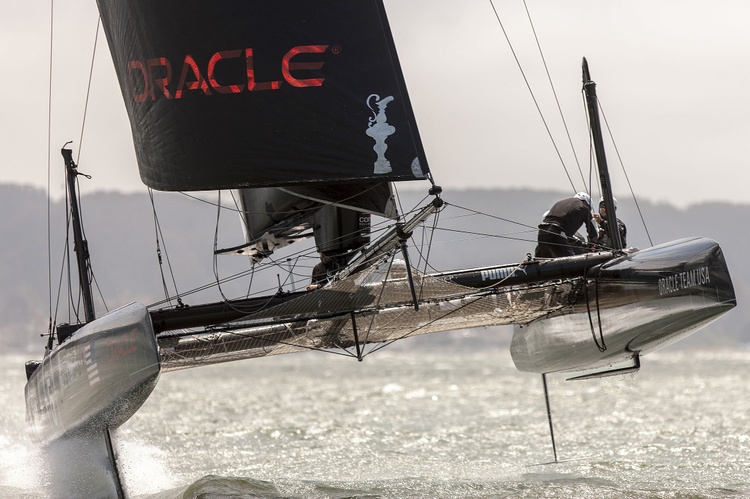America’s Cup 2013: Winds, Wings and Supercomputers
While competitive sailing has rightly earned a reputation for taking the human body to its limits, this year the America’s Cup competitors have an extra trick up their waterlogged sleeves: supercomputers.
 Since the first yachts that sailed the America’s Cup in 1851, the trend of embracing technology has brought racing teams quite a way. Today, the so-called “sailboats,” don’t even use sails, but rigid, upright wings and carbon fiber hulls that encourages the craft to skim over the water’s surface rather than dipping into it.
Since the first yachts that sailed the America’s Cup in 1851, the trend of embracing technology has brought racing teams quite a way. Today, the so-called “sailboats,” don’t even use sails, but rigid, upright wings and carbon fiber hulls that encourages the craft to skim over the water’s surface rather than dipping into it.
Now, the international sailing teams are using high performance computing (HPC) resources to fine-tune the performance of each 13,000-lb sailboat, calculating the effects of something even as small as how half a degree change in wing position will help the craft more quickly reach the finish line.
As Emirates Team New Zealand’s crew are out at sea bracing for spray, their partner team at Dell are buckling down to test virtual models and compare the New Zealand boat to those of their competitors. The supercomputer cluster includes Dell’s PowerEdge C servers and storage, along with HPC-optimized network storage. On top of that the computer giant has also provided day-to-day resources such as a visualization environment and other basic IT functions.
For the New Zealand team, Nick Holroyd holds the post of technical director, and has said that computing power is now the core of yacht design. “A big computer like this is the lifeblood of the design group, in the way that the wind tunnel was a decado ago,” he said.
“You would look at: Is there applicability to my boat?” said Bryan Jones, Dell’s vice president of marketing, in an interview with NPR. If so, “I’d go back and I’d potentially do that on my boat as well.”
And beyond analyzing sailing technique, the New Zealand-based supercomputer will also be used to analyze weather patterns that could offer the team a competitive edge come race day.
But in racing, compute power is no substitute for manpower. Earlier this week when Emirates Team New Zealand came close to capsizing in the San Francisco Bay, the sailing team had to work through the night to retool their catamaran. Even then, the effort wasn’t enough to give them the edge they needed over their rivals and defending champions, Oracle Team USA.
With a narrow, 47-second edge over other boats, a radio broadcaster noted that the American team sailed to victory with “a completely different boat than what we’ve seen in the past.”
In reality, the boat was a modification of previous models, not something altogether different. One spectator noted that the redesign was likely an effort to lighten the craft.
“What they’ve done has made the difference,” said spectator Dan Thompson. “It’s given them those extra couple of knots they were lacking the previous six or seven races.”
But some modifications come at a cost. In one of the biggest cheating scandals in the America’s Cup’s 162-year history, Oracle Team USA was docked two of its four points for illegally modifying it’s prototype during the warmup regattas of the America’s Cup World Series.
Still, Emirates Team New Zealand is positioned to win back the America’s Cup, despite a string of delays caused by winds exceeding the competition’s limits.
Before one of their races, Gilberto Nobili—an Italian racer who fulfills Oracle Team USA’s “grinder” role by moving the foils along the boat’s underbelly that helps it skate over the ocean’s surface—huddles with a group of designers and mathematicians, all tasked with tweaking every imaginable sailing variable to ensure an American victory. They review the 3,000 variables collected ten times a second to see if they can pinpoint areas that could be improved.
“You collect the data, you get a kind of report, and then you go into a sailing team meeting, a design meeting, and you discuss which is the best way to move forward,” Nobili said to NPR.
Although Nobili couldn’t reveal exactly how they’re putting supercomputing to use in their designs, he admitted that the process was an amazing one.
Holroyd explained to NPR that only a few tournaments ago, the Kiwis had 30 sailors to 15 engineers, but there has since been a turnaround in the team’s approach.
“We’ve had to kind of sit down with the sailing team and almost invent a new language,” he said.
During each race, Holroyd is close by his team’s side in a motorboat that allows him to monitor the catamaran’s data in real time. And because the boat’s rise above the water’s surface, deciphering the gathered information is not a simple task.
“Now because we pick the boat up, you’re really looking at a three-dimensional physics problem,” Holroyd said. “So just the number of cases that we need to run to understand how a hull’s going to behave has gone up exponentially.”
But not everybody is ready to embrace the compute power that this calls for.
“We went from a gentleman’s sport, good sailing, decent skippers, sometimes overweight—it didn’t matter—to very high tech,” explained spectator Ricardo Romani to NPR. “I think this is going to [be the] start of a new era for sailing.”










